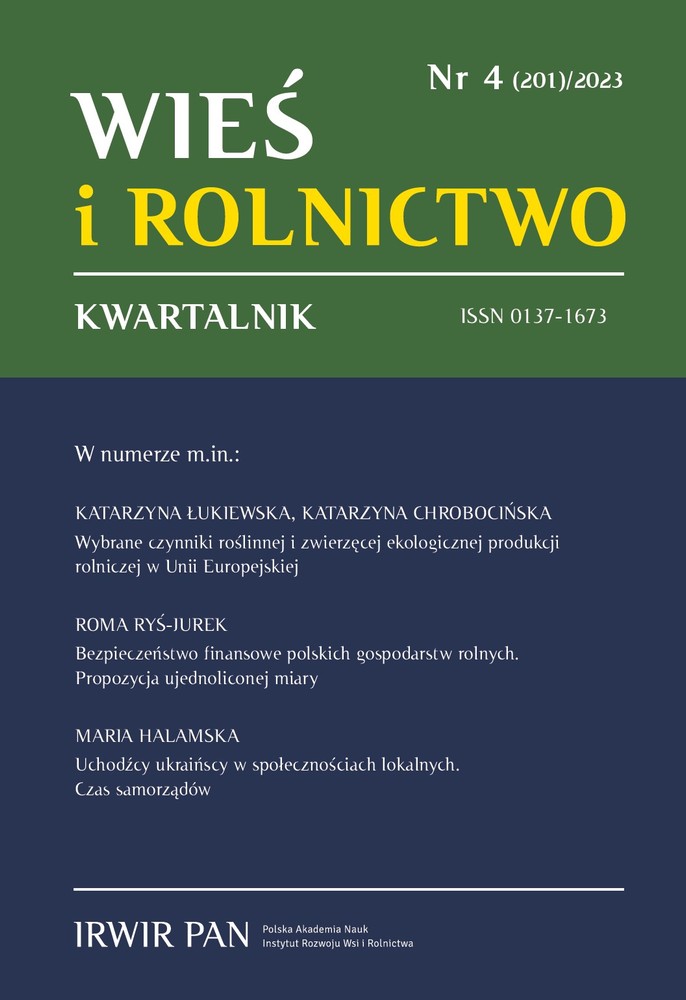Matrix Assessing the Impact of Intervention Actions on Sectors in Agricultural Production
DOI:
https://doi.org/10.53098/wir.2023.4.201/03Keywords:
matrix approach, quantification of policy impact, agricultural sector, intervention actionsAbstract
The aim of this article was to demonstrate the potential of using matrix accounting to determine the direct and indirect impact of selected sectoral intervention actions on agriculture. The reasoning has been divided into four stages. The starting point was mapping the relationships between intervention actions and agricultural production sectors. The article considered nine different intervention instruments and four sectors of agricultural products. In the second stage of the study, the share of each intervention action in the production of a given sector was estimated, enabling an assessment of the impact of these actions on the sectors. The third stage of the study involved determining the direct and indirect effects of intervention actions on specific agricultural production sectors. In the final stage, the share of the value of intervention activities in the value of commodity production in a given sector was assessed. The entire research process allowed for a quantitative assessment of the impact of intervention actions on agricultural production sectors. In terms of content, the analysis based on this approach allows for the following general conclusions. Firstly, horizontal income-generating actions are crucial in the context of supporting incomes in the examined sectors. Secondly, although the impact of individual actions on the examined sectors is considered separately as at most sufficient or insignificant, the cumulative impact of these actions on individual sectors is significant. Thirdly, there is a logical relationship in shaping the map of the impact of actions on sectors. The sectors that are both sensitive to changes in economic production conditions and significant for the ecological system of agricultural production, where a return to production may be more challenging and where support for resilience and stability is particularly needed, receive the most support.
References
Ambroziak Ł. (2021). Znaczenie agrobiznesu w gospodarce polski. Analiza z wykorzystaniem tablic przepływów międzygałęziowych. Zagadnienia Ekonomiki Rolnej, 3 (368), 3–27. DOI: https://doi.org/10.30858/zer/138427
Baumol W. (2000). Leontief ’s great leap forward. Economic Systems Research, 12, 141–152. DOI: https://doi.org/10.1080/09535310050005662
Bear-Nawrocka A., Mrówczyńska-Kamińska A. (2019). Materiałochłonność i importochłonność w rolnictwie Unii Europejskiej w świetle przepływów międzygałęziowych. Zagadnienia Ekonomiki Rolnej, 1 (358), 3–21. DOI: https://doi.org/10.30858/zer/104514
Bear-Nawrocka A., Mrówczyńska-Kamińska A. (2015). Sytuacja dochodowa a przepływy materiałowe w rolnictwie w krajach Unii Europejskiej. Problemy Rolnictwa Światowego, 15 (3), 5–16. DOI: https://doi.org/10.22630/PRS.2015.15.3.33
Czyżewski A. (2011). Przepływy międzygałęziowe jako makroekonomiczny model gospodarki. Materiał uzupełniający do wykładu z makroekonomii. Poznań: Wydawnictwo Uniwersytetu Ekonomicznego.
Czyżewski A., Grzelak A. (2018). Application of the input-output model for structural analysis on the example of the agricultural sector in Poland. Management, 22 (2), 285–298. DOI: https://doi.org/10.2478/manment-2018-0037
Czyżewski A., Grzelak A. (2009). Możliwości oceny rozwoju rolnictwa w warunkach globalnych z zastosowaniem tabeli przepływów międzygałęziowych. Roczniki Naukowe Stowarzyszenia Ekonomistów Rolnictwa i Agrobiznesu, 11 (2), 43–48.
EC [European Commission] (2016). Directorate-General for Agriculture and Rural Development – Unit E.4. Guidelines Assessment of RDP Results: How to Prepare for Reporting on Evaluation in 2017. European Evaluation Helpdesk for Rural Development. Brussels: European Union.
Esposti R., Sotte F. (2013). Evaluating the effectiveness of agricultural and rural policies: An introduction. European Review of Agricultural Economics, 40 (4), 535–539. DOI: https://doi.org/10.1093/erae/jbt014
Gurgul H., Majdosz P. (2006). Identyfikacja klastrów w oparciu o strukturę nakładów i wyników. Zeszyty Naukowe Szkoły Głównej Gospodarstwa Wiejskiego w Warszawie. Ekonomika i Organizacja Gospodarki Żywnościowej, 60, 103–112. DOI: https://doi.org/10.22630/EIOGZ.2006.60.31
GUS [Główny Urząd Statystyczny] (2021). Rocznik Statystyczny Rolnictwa 2021. https://stat.gov.pl/obszary-tematyczne/roczniki-statystyczne/roczniki-statystyczne/rocznik-statystyczny-rolnictwa-2021,6,15.html (dostęp: 10.03.2023).
Leontief W.W. (1941). The Structure of the American Economy. New York: Oxford University Press.
Leontief W.W. (1936). Quantitative input-output relations in the economic system of the United States. Review of Economics and Statistics, 18, 105–125. DOI: https://doi.org/10.2307/1927837
Monke E.A., Pearson S.R. (1989). The Policy Analysis Matrix for Agricultural Development. Ithaca–London: Cornell University Press. https://www.cepal.org/sites/default/files/courses/files/03_3_pambook.pdf (dostęp: 20.06.2023).
MRiRW [Ministerstwo Rolnictwa i Rozwoju Wsi] (2023). Plan Strategiczny dla Wspólnej Polityki Rolnej na lata 2023–2027. https://www.gov.pl/web/wprpo2020/skrocona-wersja-planu-strategicznego-dla-wspolnej-polityki-rolnej-na-lata-2023-2027-skrocona-wersja-11 (dostęp: 21.06.2023).
Mrówczyńska-Kamińska A. (2013). Wykorzystanie modelu przepływów międzygałęziowych do badania zależności w agrobiznesie w k rajach Unii Europejskiej. Referat na IX Kongres Ekonomistów Polskich, 1–8.
OECD (2023). Reader’s guide definition of OECD indicators of agricultural support. https://www.oecd-ilibrary.org/sites/agr_pol-2018-2-en/index.html?itemId=/content/component/agr_pol-2018-2-en (dostęp: 22.06.2023).
Przybyliński M., Gorzałczyński A. (2016). Zastosowanie tablic przepływów międzygałęziowych do modelowania procesów inflacyjnych. Gospodarka w Praktyce i Teorii, 42 (1), 51–62. DOI: https://doi.org/10.18778/1429-3730.42.04
Wieliczko B. (2019). Dylematy tworzenia długookresowej polityki rolnej. Seria: Studia i Monografie, 173. Warszawa: Dział Wydawnictw IERiGŻ-PIB.
Wieliczko B. (2018). System oceny wsparcia programów rozwoju obszarów wiejskich 2014–2020. Problemy Rolnictwa Światowego, 18 (1), 309–318. DOI: https://doi.org/10.22630/PRS.2018.18.1.28











